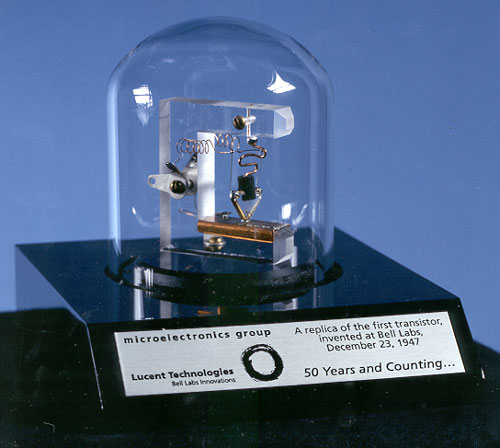Moore’s law dictates that the number of transistors in integrated circuits doubles approximately every 18 to 24 months, but as transistor size approaches atomic levels, quantum physics renders them obsolete in their current state. Once the semiconductor shrinks to the size of a single nanometer, it encounters a different set of physical laws than on the macro stage; this discrepancy has the potential to hinder the exponential technological growth of the last five decades.
Transistor recap
Transistors are a fundamental semiconducting device incorporated into all of today’s electronics. They are a chief component of integrated circuits, responsible for revolutionizing as well as miniaturizing technology, and they are successors to the vacuum tubes of the early 20th century. The “on” and “off” semiconductor property of a transistor’s gate allows them to be commonly used as electrical switches for either high-power or low-power applications as well.

A replica of the first working transistor
Moore’s law is not law
Moore’s law is not actually physical law, but rather an observation, rooted in human behavior, that was made by Intel co-founder Gordon Moore in 1965. Transistors double every two years because market competition drives companies to race over who will be first to reach the next round of improvements. As a result, integrated chips grow in proficiency as well. Subsequent components are then made from these updated components, and the cycle repeats itself until the very miniaturization that drives advancement reaches a physical restriction ― at least under present technology.
Quantum defects
Quantum tunneling is the main culprit behind limitation. When materials reach the size of a single nanometer, equivalent to 10 atoms thick, electrons will flow straight through them as if the material were not actually present. Gates within transistors will be rendered virtually useless, unable to control the flow of electrons which are now essentially teleporting from one side of the material to the other. Transistors cannot function with leaky gates. Their entire principle relies on altering the flow between sources and drains using insulated gates and varying charges.
The obstruction of Moore’s law has been predicted multiple times over the ensuing decades since the conception of transistors, but engineers have always devised a solution. However, transistors will no longer work once they reach atomic proportions. The entire fundamental science behind circuit design must change or risk stagnation – that or design a substitute to the transistor.
Present transistor size
A human hair measure 100,000 nanometers in thickness. Intel’s Haswell CPU chips host 1.4 billion transistors with a 22-nm thickness. These transistors are even smaller than the wavelengths of visible light, which measure 400 to 700 nm.
The Haswell and Xeon chip feature billions of transistors; at 22 nanometers thick they approach physical limits. Image courtesy of TheTechBlock.
The end of Moore’s law
Recalling that the previous generation of Intel’s CPU chips hosted transistors the size of 32 nm, it would appear that the end of Moore’s law is imminent, maybe as soon as 2020. Nevertheless, if the past is an indicator of anything, it’s that this is simply not true. Too much economy is at stake for giant semiconductors such as Intel and Fairchild to simply cease innovating, though it does raise the question of whether we are on the cusp of a new technological revolution ― the transition from digital to quantum computing.
Discuss your thoughts on the future outlook of transistor miniaturization on TechXchange.
Advertisement
Learn more about Digi-Key





